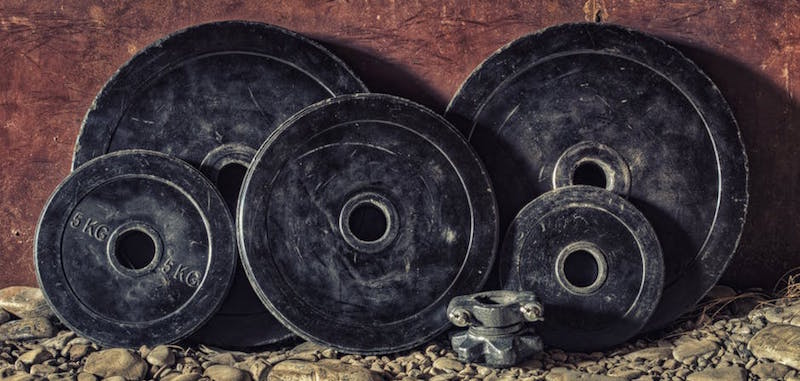To Lift or Not to Lift: What the Science Says About Weight Lifting & Tension
There's a lot of pressure exerted on singers to have and maintain a figure casting directors want to put on stage. With summer fast approaching, that constant pressure is only going to increase. While getting into shape is a daunting prospect for the average person, it is even more complicated for singers. Our livelihood depends on us being able to use our bodies in dynamic ways, and we are always advised to take care of our instruments. Because of this, a sentiment has spread that singers should approach certain forms of exercise with caution, or even avoid them completely. No form of exercise elicits a more powerful negative response in singing circles than weightlifting. But is all of this caution warranted? Let us look at where these anti-weightlifting sentiments come from and what the clinical data has to say about the subject.
What’s so wrong with pumping iron?
While different teachers and coaches have their own personal reasons or anecdotes behind banning the dumbbell, one idea permeates everything: lifting will make you tense, and avoiding tension has been the center of singing technique and pedagogical literature for centuries.
“At the foundation of all good tone production is relaxation. This rather oracular statement does not present a new truth; relaxation has been preached and insisted upon sufficiently, one would think, to fully impress its importance upon the dullest student's mind.”
-Arthur Manchester in Twelve Lessons in the Fundamentals of Tone Production (1908)
And that is the crux of the matter: voice teachers know that tension is a primary cause of many vocal issues, and there is a presumed connection between resistence training, or RT, and tension. It seems logical to assume that lifting weights, which involves repeatedly tensing your muscles, would cause those muscles to become more tense in general. None the less, all pertinent clinical data I have found shows that RT decreases tension, and there is an inverse relationship between strength and tension. Despite this, many teachers and singers conflate the fact that tension is bad for singing with the assumption that RT causes tension, creating the notion that RT is bad for singing. The undeniable truth of one idea has applied to the other without proper research.
What does the science say?
While there have been studies on muscle activation while singing[1][2], there have been no studies observing the effects of resistance training on singing in any capacity. Herein lies the first problem with this subject and the claims surrounding it: there has not been enough direct research to say definitively what the effects of RT on singing are. Anyone who says they know for a fact that RT is good or bad for singing is saying so in the absence of proper clinical evidence. In the absence of this subject-specific data, I have collected and will present clinical data on the effects of RT on tension in general.
Show me the study!
The body of research I found regarding RT and tension falls into three categories: studies pertaining to the effects of RT on muscle activation, studies measuring RT and similar stimuli on tension related disorders, and studies observing RT’s effects on flexibility.
For the sake of brevity, I will list the general conclusions of the studies. If you wish to view the studies in detail, they are cited at the end of the article and are available on EBSCO host, Academic Search Complete, and other scholarly medical databases.
- A study measuring the effects of RT on muscle tension found that engaging in a consistent RT regimen resulted in a dramatic decrease in muscle activation and tension over time[3].
- A study comparing the strength of chronic tension type headache (CTTH) suffers and controls found that those suffering from CTTH were weaker[4]. A similar study found that pain related to CTTH decreased as neck strength increased[5]. This study concluded that tension and tension related disorders have an inverse relationship to muscle strength.
- Multiple studies have shown that both RT and muscle activation in the form of Transcutaneous Electrical Nerve Stimulation (TENS) are effective in combating tension related disorders and illnesses[6][7][8][9].
- Every pertinent study observing the effects of RT on flexibility showed RT to either have no effect or increase it [10][11][12][13]. In one study RT proved equally effective as traditional stretching in increasing flexibility[14].
What does all of this mean?
As I mentioned before, the basic premise behind the claims stating that weightlifting and RT have a negative effect on singing is that RT causes tension. The twelve studies cited above are just a sample of clinical data pertaining to RT and its effects on muscle tension and flexibility. All of that data directly contradicts that premise. These studies do not prove that RT has no effects on singing, just that RT does not cause an inherent increase in muscle tension, and it likely has the inverse effect: reduced tension and increased flexibility.
Twelve studies would not be considered proof by any scientific standard, but there are zero studies supporting the theory that RT causes tension. Therefore, the theory that RT does not cause tension, should be the accepted one.
There is still room for caution
While there is evidence which appears to disprove the assumed connection between weightlifting and tension, that does not mean that there cannot be negative effects from picking up the dumbbell. These precautions have no basis in clinical data, but are still valuable to keep in mind.
1. Don’t let your lifting technique become your singing technique.
While there is no evidence that weightlifting is a direct physiological or biomechanical cause of increased tension, that doesn’t mean a person can’t respond to a new RT regimen by approaching singing with greater tension. When beginning a new RT regimen, make sure that the pushing and pulling stays in the gym and doesn't follow you into the practice room or onto the stage. Be cautious of pushing or tensing while singing.
2. Be prepared for changes in abdominal and intercostal strength.
As muscles become stronger, tasks which rely on those muscles often become easier. Most weightlifting exercises utilize the abdominal and intercostal muscles to stabilize the torso. Compound and dynamic moves such as the deadlift and squat use these muscles even more. As these muscles develop, the amount of effort required to generate the same amount of support while singing may decrease. While this is a good thing, the sensations you feel may change. Be aware of these changes and avoid over supporting.
3. Don’t take unnecessary risks.
Doing new exercises, consuming new supplements, and engaging in new tasks all exert new pressures on the body. Starting a new workout program can introduce a lot of new variables into a person’s life, especially if they have not lifted before. As singers, we have to be the kings and queens of consistency. Be careful when doing new things, and never underestimate the effect those new things can have on your body and voice. Performance day is not the day to discover what happens to your voice following a leg workout.
4. Be prepared for scrutiny.
I could write a book on the comments, lectures, and advice, both solicited and unsolicited, I have received over the years regarding my body and fitness regimen. My continued entrees into lifting have always been met with scrutiny, but mostly loving concern. Remember that most teachers and singers have been taught to approach RT with caution if at all. Upon hearing you have picked up the barbell, they may warn you against RT, or even forbid you from lifting. Be prepared, and don’t take it as a personal offense. These warnings usually come out of genuine concern for you and your voice, so don’t take it as an affront.
Conclusion
This article should not end the conversation, but begin it. While the operatic singing tradition is over 400 years, the detailed clinical study of the voice and its response to different stimuli is comparitively young. It may seem fruitless to apply the scientific process to confirm things we consider to be fact, but when we make assumptions about the vocal process and how it connects to the singer’s mind, body, and soul, we run the risk of spreading misinformation. The opera industry is becoming more competitive every year, and singers need every advantage. RT and its benefits may help and even be the deciding factor in a singer’s path to success. We mustn’t dismiss it without proper evidence.
The verdict is not out on how RT effects singing. Until the subject has been studied directly, we are left with hypotheses. Hopefully this article will push the conversation in the direction of fact and observable data and away from opinion and superstition. Honest answers can only come out of honest and free dialogue.
Sources Cited
[1] Pettersen, V., and R. H. Westgaard. "Muscle Activity in Professional Classical Singing: A Study on Muscles in the Shoulder, Neck and Trunk." Logopedics Phoniatrics Vocology 29, no. 2 (May 2004): 56.
[2] Pettersen, Westgaard. "The Activity Patterns of Neck Muscles in Professional Classical Singing." Journal Of Voice 19 (March 2005): 238-51.
[3] Lidegaard, Mark, Rene B Jensen, Christoffer H Andersen, Mette K Zebis, Juan C Colado, Yuling Wang, Thomas Heilskov-Hansen, and Lars Andersen. "Effect of Brief Daily Resistance Training on Occupational Neck/Shoulder Muscle Activity in Office Workers with Chronic Pain: Randomized Controlled Trial." Biomed Research International 2013, (December 2013): 1-11.
[4] Bjarne K Madsen, Karen Søgaard, Lars L Andersen, Jørgen H Skotte, and Rigmor H Jensen. “Neck and Shoulder Muscle Strength in Patients with Tension-Type Headache: A Case-Control Study.” Cephalalgia 36, no.1 (April 2015): 29-36.
[5] Castien, Rene, Annette Blankenstein, and Willem De Hertogh. "Pressure Pain and Isometric Strength of Neck Flexors are Related in Chronic Tension-Type Headache." Pain Physician 18, no. 2 (March 2015): 201-5.
[6] Andersen, Christoffer H, Lars L Andersen, Mette K Zebis, and Gisela Sjøgaard. "Effect of Scapular Function Training on Chronic Pain in the Neck/Shoulder Region: A Randomized Controlled Trial." Journal Of Occupational Rehabilitation 24, no. 2 (2014): 316-24.
[7] Dellve, Liotta, Linda Ahlstrom, Andreas Jonsson, Lief Sandsjö, Mikael Forsman, Agneta Lindegård, Christina Ahlstrand, Roland Kadefors, Mats Hagberg. "Myofeedback Training and Intensive Muscular Strength Training to Decrease Pain and Improve Work Ability Among Female Workers on Long-Term Sick Leave with Neck Pain: A Randomized Controlled Trial." International Archives Of Occupational And Environmental Health 84, no. 3 (March 2011): 335-46.
[8] Bazzotti, L. "Electromyography Tension and Frequency Spectrum Analysis at Rest of Some Masticatory Muscles, Before and After TENS." Electromyography and Clinical Neurophysiology 37, no. 6 (September 1997): 365-78.
[9] Gladwell, Peter William, Kathryn Badlan, Fiona Cramp, and Shea Palmer. "Direct and Indirect Benefits Reported by Users of Transcutaneous Electrical Nerve Stimulation for Chronic Musculoskeletal Pain: Qualitative Exploration Using Patient Interviews." Physical Therapy 95, no. 11 (November 2015): 1518-28.
[10] Breukelman, G.J., J.Anderson, and J.P. Pinard. "Variable Isotonic Resistance Training in Lower Limb Strength and Flexibility of Recreational Cyclists and Runners." African Journal For Physical, Health Education, Recreation & Dance 21, no. 1:1 (March 2015): 59-68.
[11] Saraiva, Alam R., Victor M. Reis, Pablo B. Costa, Claudio M. Bentes, Gabriel V. Costa e Silva, and Jefferson S. Novaes. "Chronic Effects of Different Resistance Training Exercise Orders on Flexibility in Elite Judo Athletes." Journal Of Human Kinetics 40 (March 2014): 129-37.
[12] Carneiro, Nelson H., Alex S. Ribeiro, Matheus A. Nascimento, Luís A. Gobbo, Brad J. Schoenfeld, Abdallah Achour Júnior, Sebastião Gobbi, Arli R. Oliveira, and Edilson S. Cyrino. "Effects of Different Resistance Training Frequencies on Flexibility in Older Women." Dove Press 2015, no.10 (March 2015): 531-8.
[13] Billson, John H., Jones F. Cilliers, Juan J. Pieterse, Brandon S. Shaw, Ina Shaw, and Abel L. Toriola. "Comparison of Home and Gymnasium-Based Resistance Training on Flexibility in the Elderly.” South African Journal For Research In Sport, Physical Education & Recreation 33, no. 3 (December 2011): 1-9.
[14] Morton, Sam K, James R. Whitehead, Ronald R. Brinkert, Dennis J. Caine. "Resistance Training vs. Static Stretching: Effects on Flexibility and Strength." Journal Of Strength & Conditioning Research 25, no. 12 (December 2011): 3391-8.








